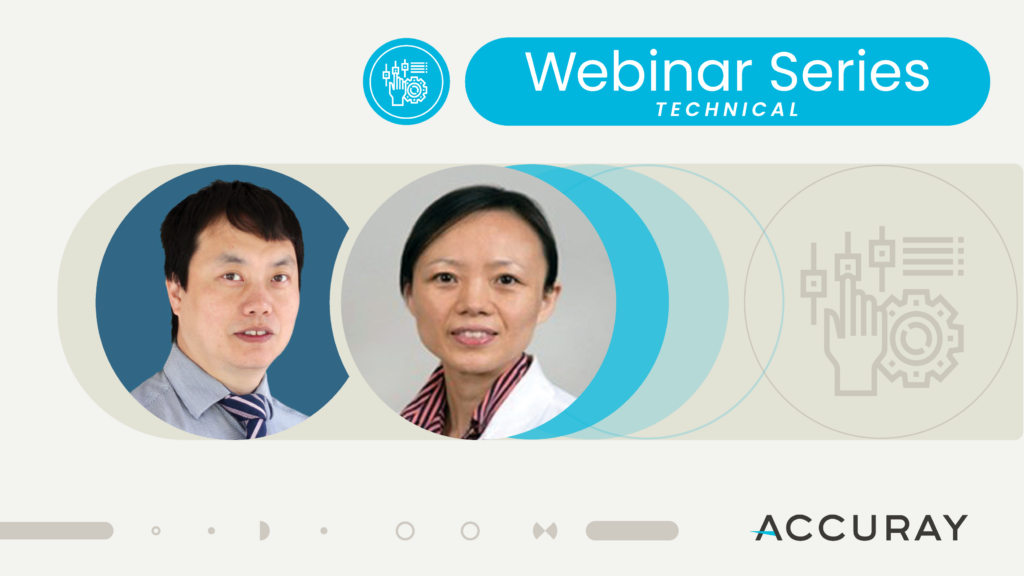Radixact® Clinical Experience at Max Institute of Cancer Care, India

During this webinar, Dr. Saini and Mr. Balasubramanian will share the Max Institute of Cancer Care, Vaishali, India Radixact® X9 System experience.
Fireside Discussion: Prostate Radiotherapy Advances

Dr. Khoo, Clinical Oncologist, The Royal Marsden, London and Dr. Blacksburg, VP, Chief Medical Officer (AMS), Accuray during this webinar will discuss the highlights from the September prostate webinar series and share their expert perspective on the future advances in prostate Stereotactic Body Radiotherapy (SBRT) and hypofractionated treatments.
September Series: Evidencing the Future – Prostate Radiotherapy Advances for Routine Practice

In September, during prostate cancer awareness month, the Accuray Exchange is hosting a special webinar series to highlight the growing evidence and advances in prostate Stereotactic body radiotherapy (SBRT) and hypofractionated treatments using CyberKnife®️, TomoTherapy®️ and Radixact®️ Systems. In this series you will hear from leading experts from the field of prostate radiation oncology, sharing their […]
Introduction of Real-Time Motion Synchronization Technology on the Radixact® System

Stereotactic radiotherapy for lung cancer has seen an increase in the number of cases treated, especially in elderly patients. In addition, the indication for stereotactic body radiotherapy(SBRT) for oligometastatic cases is rapidly expanding, as well as an increasing number of SBRT treatments in the abdominal region. For SBRT in the abdominal region and lower lung field, measures against the respiratory motion are important. Synchrony® is a technology that enables tracking and irradiation of moving targets. It is expected to guarantee the dose to the moving tumor and reduce the irradiation volume of normal tissues. However, to provide safe and reliable treatment, it is necessary to understand the Synchrony mechanism and its characteristics.
MyAccuray Webinar: Initial Experience of VOLO™ Ultra Optimizer for the Radixact® System

Join Lee Goddard and Jin Shen as they share Montefiore Medical Center’s Department of Radiation Oncology’s initial experience of the VOLO™ Ultra Optimizer for the Radixact® System. Montefiore Medical Center’s Department of Radiation Oncology strives to develop and incorporate the newest technologies and methods available to combat the progress of cancer and outstanding radiation oncology care is crucial for many of their patients with the disease. Since installing the Radixact System at the Moses campus in 2017, Montefiore has been an early adopter of both Synchrony® and ClearRT™ for the Radixact System. The utilization of VOLO Ultra Optimizer for treatment planning has allowed them to ensure the best plans are created and delivered to patients. This webinar will present Montefiore Medical Center’s initial experience with VOLO Ultra.
Total Body Irradiation (TBI): Migrating from Linac Based Open Field Technique to TomoTherapy®

Join Dr. Deepak Gupta as he explores the role of Total Body Irradiation (TBI) in the treatment of hematologic malignancies. The objective of this webinar is to explain the background & rationale of treatment, clinical application, and clinical experiences utilizing TomoTherapy®/Radixact® Treatment Systems. Dr. Gupta will share the experience of the Medanta Cancer Institute, TBI TomoTherapy program.
MyAccuray Vision: Real-time Online Adaptive Radiotherapy

This preview shows a smooth and efficient workflow for online adaptive radiotherapy delivery* on the Radixact®️ System. This solution would be useful for those customers who are using a combination of Accuray Systems with RaySearch products. Using high-quality Radixact ClearRT™️** images and the efficient and smooth adaptive replanning framework of RayStation and RayCare®️, the patient’s treatment plan can be adapted based on the daily diagnostic-like fan-beam kVCT images by utilizing RayStation’s advanced features such as deep learning artificial intelligence (AI) segmentation and GPU-based dose computation and delivered using continuous 360-degree precision of helical treatment and tumor tracking with dynamic delivery on the Radixact System.
TomoTherapy® in Nasopharyngeal Carcinoma

Nasopharyngeal carcinoma (NPC) is highly prevalent in southeast of Asia, and it is predominantly treated by radiotherapy (RT). Intensity-modulated RT (IMRT) exhibits better dosimetric advantages over two-dimensional RT (2D-RT) or three-dimensional conformal RT (3D-CRT). It has significantly improved the local control rate of NPC and reduced acute and chronic toxicities. Helical TomoTherapy® was an emerging technology that integrates IMRT, image-guided intensity modulated radiotherapy (IGRT) and dose-guided intensity modulated radiotherapy (DGRT). TomoTherapy makes a perfect combination of linear accelerator and helical CT, breaking through many limitations of traditional accelerator. While rotating the irradiation target area, the treatment couch advances axially through the center of the stand, which is used to treat tumors efficiently and accurately. This webinar will focus on the treatment of NPC by TomoTherapy. Firstly, describing the therapeutic mechanism of TomoTherapy, the advantages and limitations of TomoTherapy in the treatment of tumors. This webinar will explain how to implement TomoTherapy in a patient with NPC. Finally, the experience of treating NPC by TomoTherapy in the Sun Yat-sen University Cancer Center, Guangzhou, China will be shared.
Advances in TomoTherapy®/Radixact® Treatment and QA – Guidelines from TG-306

Since the publication of Task Group 148 in 2010, the TomoTherapy platform has undergone substantial development involving treatment delivery, image guidance, motion management, and treatment planning systems (TPS). New hardware and software capabilities have dramatically changed its delivery and planning characteristics. Task Group 306 was formed to provide guidance on the implementation, management, and quality assurance for these technological advances. In this session, the work of Task Group 306 will be presented. Changes to the TomoTherapy platform since 2010 and the impact on clinical delivery and QA practices, including QA tests and tolerance limits will be presented.
MyAccuray: Implementing ClearRT™ for the Radixact® System

Dr. Lane Rosen at Willis-Knighton Cancer Center will share his insights and clinical experience of using ClearRT™, Accuray fully integrated, diagnostic-like fan-beam kVCT imaging for the Radixact® System.
